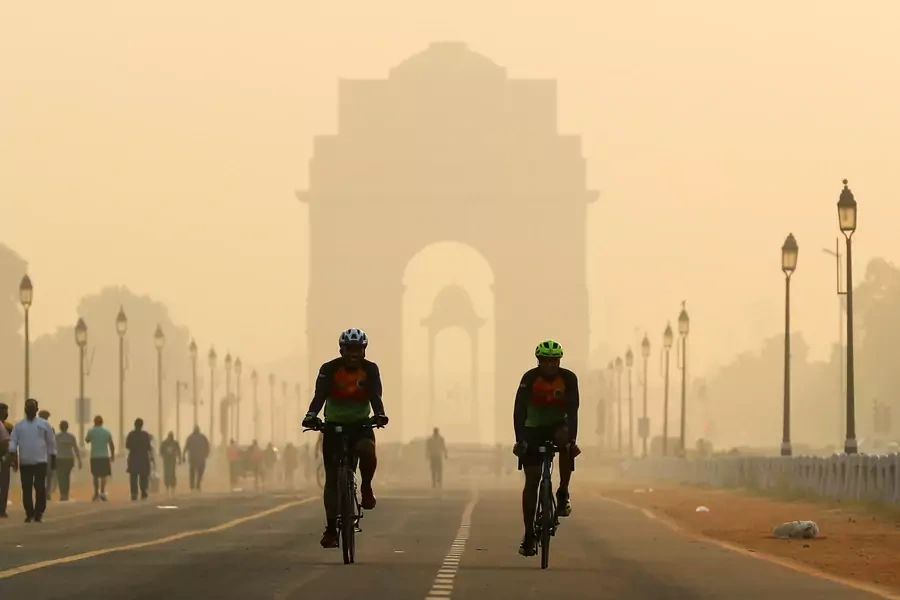Modi’s “New India” and the Politics of Architecture

On January 26, 2023, revelers in New Delhi gathered on the newly christened Kartavya Path, or “path of duty,” to celebrate India’s Republic Day, the date on which India’s constitution came into effect. Formerly known as Rajpath, or “King’s Way,” Kartavya Path was designed by English architect Sir Edwin Lutyens in 1911 as a ceremonial axis for the imperial capital of the British Raj and remains among the most well-known thoroughfares in India. Its renaming is part of Prime Minister Narendra Modi’s Central Vista redevelopment project, a flagship initiative to reshape the architecture of the Indian capital.
The project aims to renovate the stretch of British-era monuments and government buildings between the famous India Gate and the presidential palace, Rashtrapati Bhavan—including the Parliament House and the National Museum of India—all for a grand total of about 135 billion rupees or nearly 1.7 billion U.S. dollars. Though the Modi government argues that the project aims to meet the expanding needs of the government and assert a modern Indian cultural identity that is distinct from former colonial symbols, it has been critiqued for its high cost and for being an outlet for the Modi administration to forward a Hindu nationalist agenda.
More on:
The Central Vista project is intended to be a symbol of Modi’s successful second term in the lead-up to the 2024 Indian general elections. While past administrations have taken other steps to mitigate colonial remnants, such as by changing place names throughout the country, the Modi government has made the Central Vista redevelopment a capstone project in its ongoing efforts to articulate a novel formulation of the history and identity of the Indian nation. Modi refers to the project along with temple projects across the country as a part of his effort to create a “New India,” a country capable of maintaining its ancient heritage and restoring its spiritual and cultural glory while simultaneously making advancements towards its modern aspirations.
Thus, the redevelopment project is on one hand an attempt to reclaim the physical footprint of Indian national politics from the clutches of imperial aesthetics in what some consider a laudable instance of the struggle for national definition familiar to many post-colonial states. Through replacing colonial creations with the architecture of modern, independent India, the Central Vista redevelopment is supposed to reflect national pride, autonomy, and ascendancy.
However, the project’s critics see the Central Vista as an attempt by Modi to bolster his own brand of Hindu nationalism, of which the revision of Indian history is a core, explicit component. When Kartavya Path was unveiled on September 8, 2022, Modi stated, “Kingsway, or Rajpath, the symbol of slavery, has become a matter of history from today and has been erased forever. A new history has been created [...].” Concerns about revisionism are exacerbated by worries about the future of important collections from the National Museum, as the plans for the museum’s relocation are opaque. Furthermore, the new Parliament House will prominently incorporate numerous national symbols that are important in Hinduism, including the peacock, the lotus flower, and the banyan tree.
Another flashpoint is a 28-foot-tall granite statue erected at India Gate of Subhas Chandra Bose, the leader of the anti-British Indian National Army. By elevating the figure of Bose on Kartavya Path, Modi is accused of explicitly endorsing Bose’s fiery brand of militant nationalism while simultaneously de-emphasizing other Indian nationalists, like Jawaharlal Nehru and Mahatma Gandhi, who promoted a more secular, pluralistic, and peaceful vision of the Indian nation.
Opponents have also critiqued the price tag of the Central Vista project. Announced just prior to the COVID-19 pandemic in September 2019, the timeline of the project has been called into question by scholars and authorities, including opposition leader Rahul Gandhi, who claim that its funds and manpower could be better spent on pandemic relief. Others have disputed the wisdom of spending so much money on architectural renovations when it could be put toward “cleaning Delhi’s air.” However, these claims may be tenuous when put in the context of the Indian government’s total spending (about 360 billion U.S. dollars in 2021) and with the knowledge that spending on architectural renovations and environmental projects are not mutually exclusive.
More on:
The destruction or reconfiguration of cultural heritage and subsequent reframing of history by a regime in power is not a new phenomenon, nor is it specific to India. In imperial Rome, if an emperor fell out of favor, his images might be altered as part of the process now termed damnatio memoriae, meaning the “condemnation of memory.” Romans removed statues from display, reconfigured sculptures into new likenesses, and erased the names of condemned elites from inscriptions. Jumping ahead a few centuries, in recent decades statues of Communist leaders have been removed and repurposed in countries that were formerly under Soviet influence.
India is thus not alone in its need to reconcile its past with its present. Nevertheless, a closer examination of the Modi government’s actions indicates that the Central Vista redevelopment is only a small part of a broader project of Modi’s Bharatiya Janata Party to reframe the identity of the nation. Rather than critique or praise the effort to redesign the Central Vista per se, perhaps a more fruitful path forward is to consider who is being left out of this reimagined Indian identity and what this omission means for India as it aspires to become a leading world power.
Clare Harris is the research associate for India, Pakistan, and South Asia at the Council on Foreign Relations.
Andrew Gordan is an undergraduate student at Harvard University.
 Online Store
Online Store